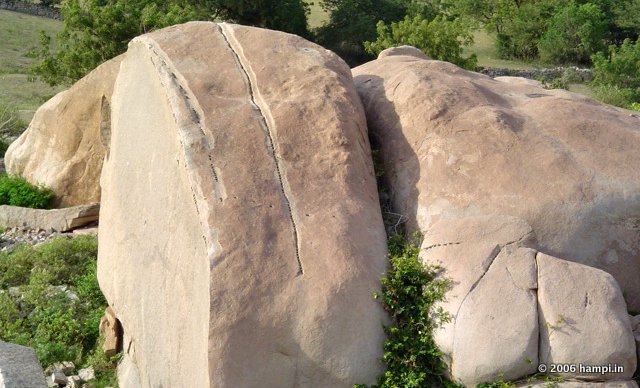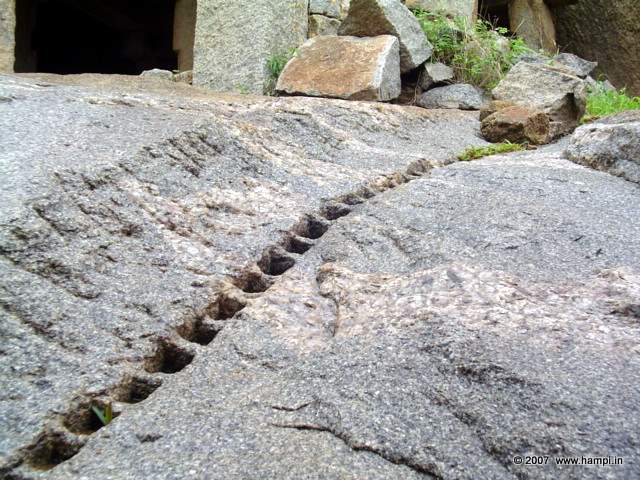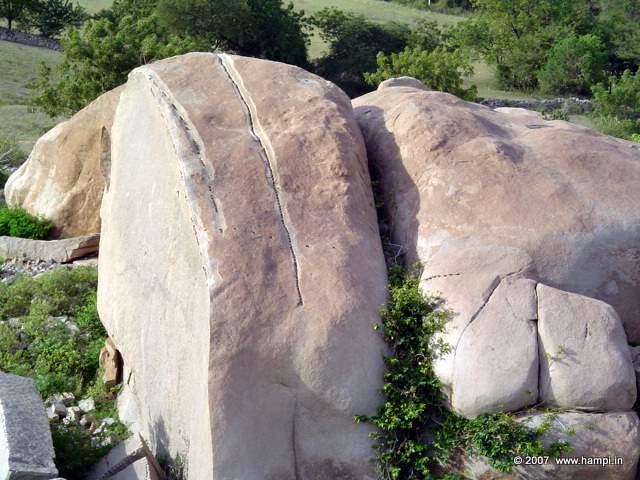Rock Cutting

A
great share of Hampi’s architecture is shaped out of rock. At least what remains of the capital is rock and rock only. Some one said every rock in Hampi has a story to tell. It’s true literally. These rock structures speak volumes of what Hampi was.One can’t help but to awe at the creativity and sheer effort in transforming an otherwise hostile terrene into a wealth capital.
A sculptor said once famously. “The sculpture was inside the rock. I simply removed the unwanted”. This is so eloquently expressed in Hampi. The only difference is here the whole city was craved out of rock, not just a few sculptures. The question is how did they manage to do such a mammoth task in those days A time when there were no machines, no sophisticated tools…. That speaks of another story about human ingenuity and dedication. Gigantic slabs of rocks were precisely cut from the boulder mountains and hills. They were then moved to the construction sites. Well even today you would find it a bit difficult to access most of these places. And we are talking about moving huge pieces of rocks weighing many tons.
As anywhere in the ancient India elephants were the power machines of the times. They used hundreds of them -in construction sites, in battlefields. No wonder so many of the elephants got its place in the carvings along with gods and kings!
Cutting huge blocks of slabs itself was an art and science. What did they use to do that - Two lest suspected items- wooden pegs and water!
A series of holes were made on the surface of the rock (along the line of cut). Then they pegged dry wooden pieces into it. Over these pegs water is poured to soak it.
The wood expands slowly by absorbing water and the shear force of these tiny peg in a row made the rock crack apart. Once the crack was developed and the rock split, it was the job of elephants and men to move them the construction site.
See the picture of the peg holes made on the rock surface. The left side of the rock is flat, means they have had cut away a slab out of it.
You would find the Royal area a bit more plane than the area close to the river. In fact the Royal area too was as rocky as the other places in Hampi. But a large quantity of rock was cut away in this area to make all the strictures at the Royal area.
You can see many such quarry sites at Hampi if you look keenly. There is one located at the Royal area. If you are near the ‘Noble men’s quarters’, you can see a mud road dividing the site. Places like The Band tower, The Mosque, The Mohammedan Watch tower etc are located at one side of the road. The ‘Noble men’s quarters’ is located at the opposite site. Standing at this point you can see a tall rock on the ‘Noble men’s quarters’ side. You can spot a flight of steps with holding rails to climb this rock. Top of this is a vantage point to get a good view of the ‘Noble men’s quarters’. From somewhere at the top of the rock you scan the rock formations down, you would be able to spot this rock!

Serrated rock surface before it is split
Serrated rock surface before it is split

An incomplete boulder split work near the ‘Noble men’s quarters’
An incomplete boulder split work near the ‘Noble men’s quarters’
Hampi Photos 1
The landscape of Hampi is filled with unending array of carvings. Some may want to call it an open museum. The carvings of religious as well as secular theme are carved on boulders in its natural settings as well as into the manmade structures. The following depicts a sample collection of such images....
